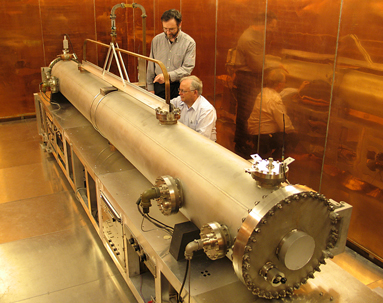#52 IV+
Cesium is a chemical element with atomic number 55. This alkali metal has some fun properties, like exploding when it comes into contact with water. With a melting point of 28.5 °C, cesium is also liquid at (slightly toasty) room temperatures.
In nature, we can find the stable isotope cesium-133 in rocks and soil, with the mineral pollucite serving as our main source. A specific cesium-133 transition is used as the basis for the official SI definition of the second. Cesium atomic clocks have been recognized as highly accurate timekeepers since the 1950s. Below, we see an image of scientists with the National Research Council Canada making adjustments to a cesium atomic clock.
Cesium-137, which Ryland finds in the laboratory, is a radioactive isotope with a half-life of ~30 years. When it decays, cesium-137 produces the short-lived barium-137m (where the m stands for metastable) and a gamma ray. Radiation concerns related to both the Chernobyl and Fukushima nuclear power plants center around the health hazards posed by cesium-137.
Having said all of that, Ryland’s “Bruce Banner Test” using cesium-137 is still not enough to penetrate the mysterious Astrophage.
I even put a few Astrophage in a radiation-containment vessel and exposed it to the gamma rays emitted by Cesium-137 (this lab has everything).
04.070
